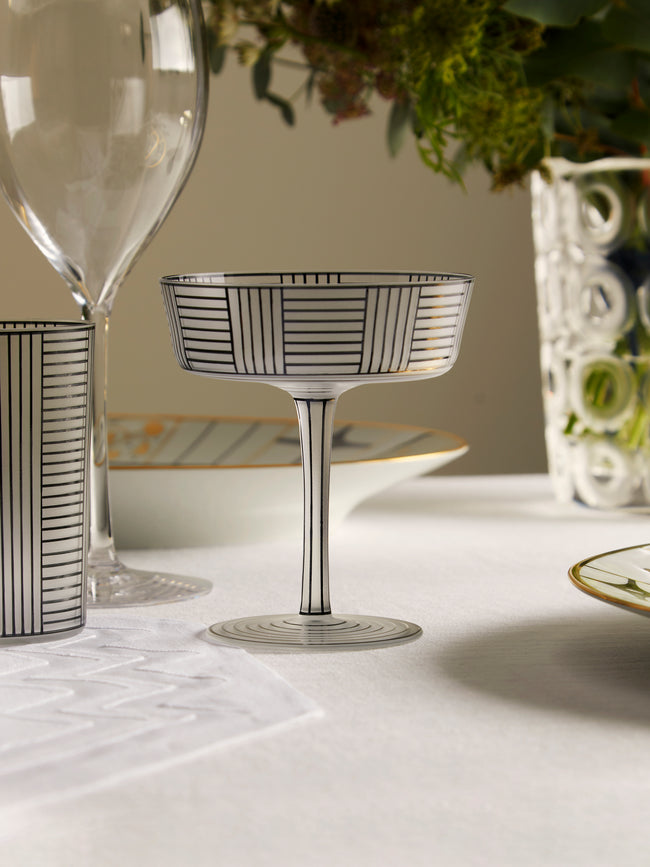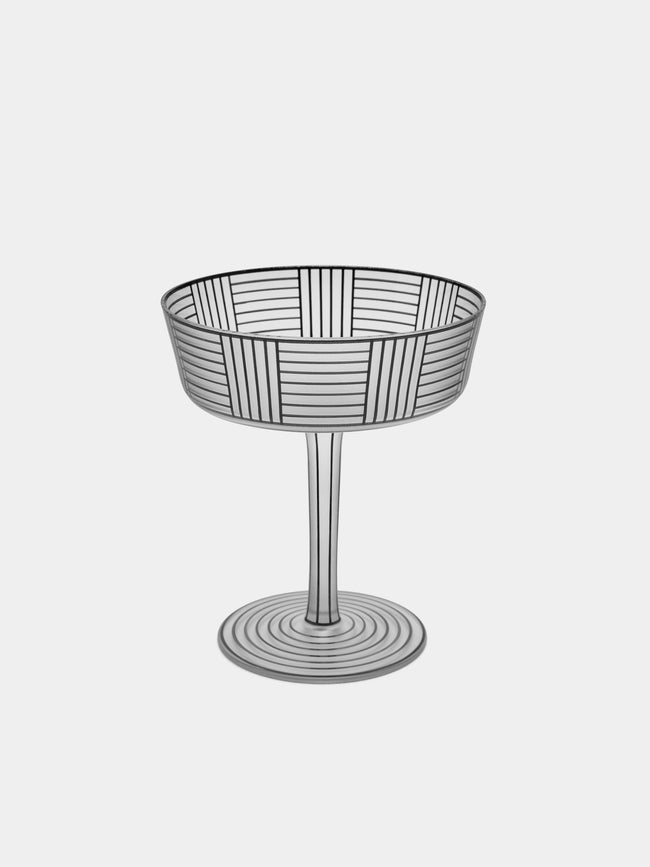

Lobmeyr
Series B Hand-Painted Crystal Champagne Coupe
$375
FREE DELIVERY on all orders over $300 and FREE RETURNS
FREE DELIVERY on all orders over $300 and FREE RETURNS
How father of Modernism, Josef Hoffmann continues to exert a design influence on modern makers today
“Hoff is the only one that can bring off a new blouse as easily as a new public building,” wrote a workmate of the prolific Austrian architect, teacher and radically moderne designer Josef Hoffmann back in 1910. More than a century later, the angular elegance and sheer exuberance of Hoffmann’s creative output – which spanned from palaces to furniture, silverware to textiles, and ceramics to jewellery – continues to hold us in thrall. Tap #josefhoffmann into Instagram, and you’ll be confronted with some 12K images of his vast oeuvre. It's a visually arresting shortcut to his greatest design hits: There’s the graphic glassware he conceived for Lobmeyr; the thrillingly minimal Bentwood geometry of the Seven-Ball Chair; the gently furling and unfurling flourish of the two-handled silver bowl; the fantastically simple Wiener Silber flatware; and again, and again, the image of the perfectly formed cigar case elaborately decorated with semi-precious stones that's more work of art than practical pocket trinket.




Reacting against the dominant Art Nouveau style, Hoffmann drew on a smorgasbord of influences, including Islamic decoration, to create compelling, eclectic and highly imaginative designs and interiors. His work is defined both by its originality and cool geometry. Informed by Charles Rennie Mackintosh, and William Morris’s liberated English Arts and Crafts ethos, in an increasingly industrialised world, Hoffmann unerringly believed in the power and the beauty of the work of the hand. In 1903, he co-founded the Wiener Werkstätte, a prodigious (though not profit-making) Viennese workshop and collective of artists and designers dedicated to bringing the idea of the Gesamtkunstwerk, or the “total work of art”, evocatively to life. Over close to thirty years, they served a slew of illustrious clients, even briefly opening a Manhattan branch. But perhaps their greatest act came in 1905-11 when the Belgian banker and collector Adolphe Stoclet commissioned the creation of Palais Stoclet, his private mansion on the outskirts of Brussels.
Hoffman forensically oversaw every inch of the sprawling, and brilliantly eccentric, 4,000 sq ft interior, from the Gustav Klimt mural that embellishes the dining room wall, to the dresses that Stoclet's Parisienne wife Madame Suzanne wore whilst hosting guests including Diaghilev, Stravinsky and Cocteau there. Widely accepted as the apex of his avant-garde Viennese Secession vision, it remained crucial to Hoffmann, who celebrated his 85th birthday there (he died aged 86).



Josef Hoffmann

Born in Moravia in 1870, the son of a politician and textile producer, Hoffmann himself was an unflappable, obsessively private and frustratingly elusive figure. “He never showed any stirring of emotion,” said a former student at the Vienna School of Applied Arts where he served as a professor. We do know that he loved to dance (he met his first wife at a fancy dress ball), often sung to himself whilst sketching out endless freehand designs in Indian ink and dressed in a monochrome suit accessorised by a Homburg hat, a walking stick and a brilliant crowd known to have included Paul Poiret, Walter Gropius and Frank Lloyd Wright. His aesthetic presaged Art Deco, modernism, Bauhaus and even Memphis (see his adjustable armchair design at the V&A). His influence can be seen in the work of Mies van der Rohe and Alvar Alto, who said: “Without Hoffmann I personally could not imagine myself.” An indefatigable do-er to the last, Hoffmann meanwhile was rather more philosophical about his achievements over his 60-year career. “What should one say about art? To make it or leave it! There is nothing to talk about, is there?”

Words by Aimee Farrell
Josef Hoffmann: The History Collection / Alamy Stock Photo
The Hall of the Stoclet Palace, Brussels, Belgium: The Print Collector / Alamy Stock Photo
Decorative Art and Architecture Section of an Exhibition Entitled Vienna 1900: Photo by Andreas Frossard/EPA/Shutterstock
Spend $300 more to enjoy free delivery
Your Shopping Bag is currently empty